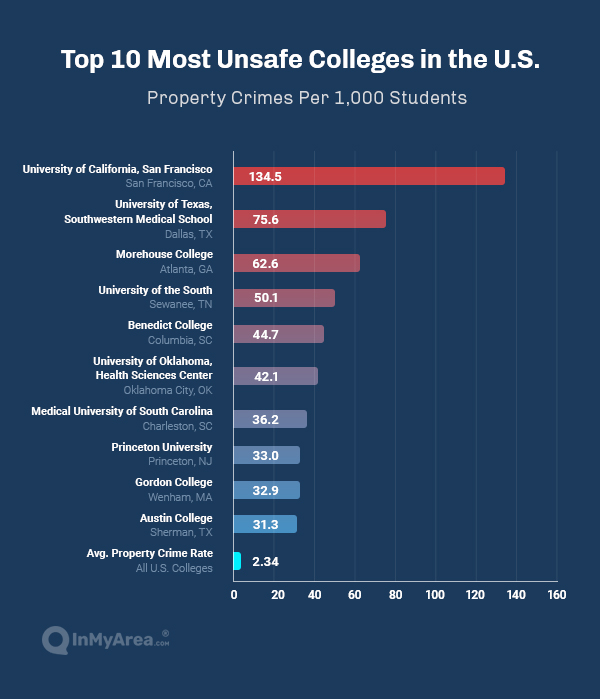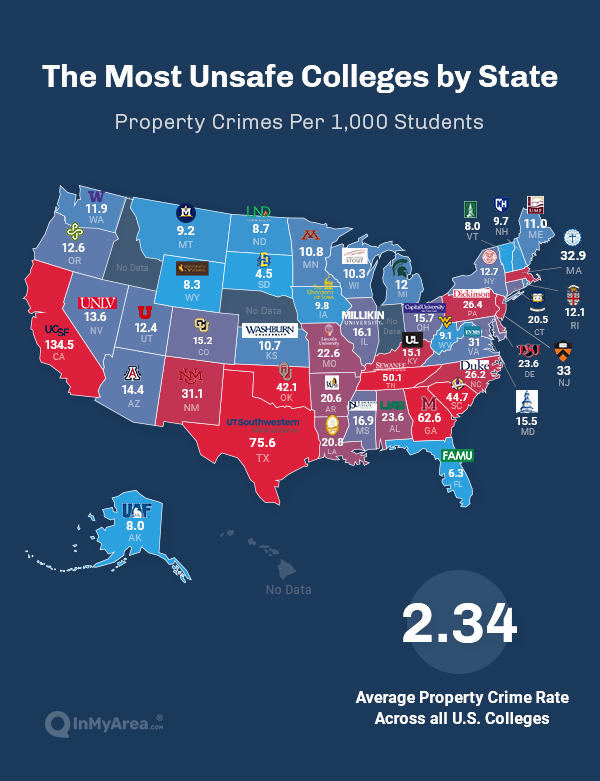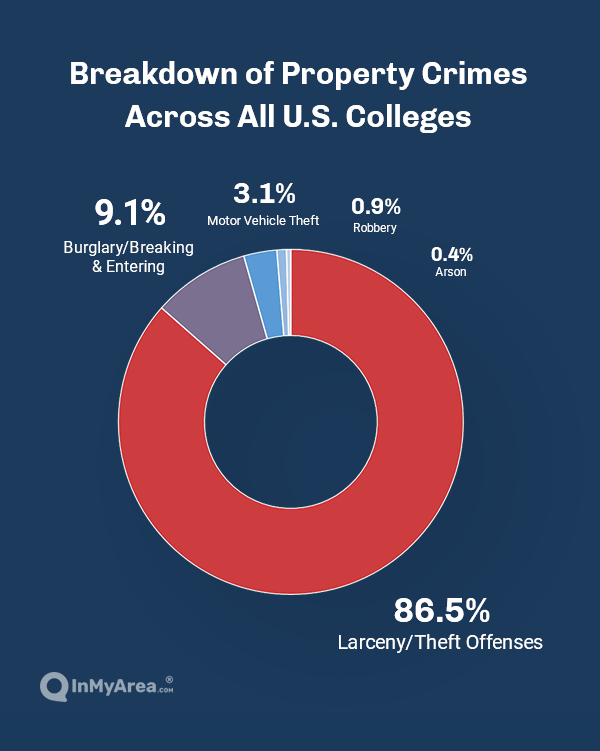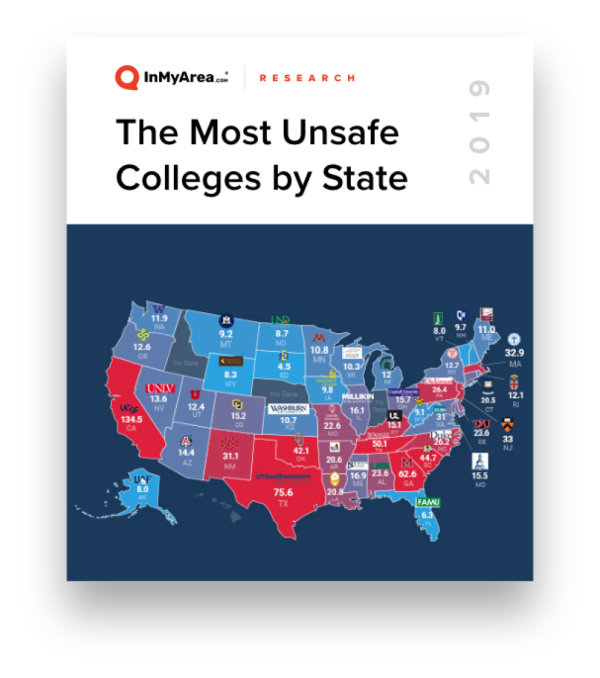Property crimes, such as theft, burglary and arson cost Americans an estimated $15.3 billion per year, and college campuses are not immune.
According to the most recent annual data released by the FBI, a property crime occurs on a college campus every 10 minutes, with more than 50,000 incidents recorded each year.
Property crime impacts every college, even the Ivy League. Princeton University ranks as the eighth unsafest campus for property crime: over one in eight Princeton students will experience property crime while pursuing a four-year bachelor’s degree.
To give students, parents, and educators an in-depth assessment of campus safety and security, InMyArea investigated U.S. colleges with the highest property crime rates and found the most common crimes on campus.
America’s unsafest colleges, ranked nationally and by state, are listed below. See where your college ranks.
- A property crime occurs on a U.S. college campus every 10 minutes and represents 95.5 percent of all criminal activity occurring on campuses
- The most unsafe colleges in each state account for over 20 percent of all property crime on U.S. college campuses
- With roughly 135 property crimes per 1,000 students, University of California–San Francisco is the most unsafe college campus in America, followed by the University of Texas–Southwestern Medical School and Morehouse College
- Arizona State University has the most frequent property crime activity, with a crime occurring roughly every 10 hours
- The average U.S. college campus employs one safety officer to protect 1,226 students
- Half of Ivy League colleges (four out of eight) ranked as their state’s unsafest college

How Rankings Are Calculated
InMyAre sources raw datasets from the latest available crime statistics published by the FBI. As part of the Uniform Crime Reporting (UCR) Program, the FBI collects and compiles crimes reported by local and regional law enforcement agencies and annually releases this data.
Property crimes are defined as larceny/theft offenses, burglary/breaking and entering, robbery, motor vehicle theft, and arson.
Using FBI datasets, InMyArea calculated and ranked the most unsafe U.S. colleges: the top 10 nationwide, by state, by crime frequency and by student-to-officer ratio. Crime rates are based on property crimes per 1,000 enrolled students.
See Methodology and Definitions for more information.
Top 10 Most Unsafe Colleges in the U.S.
These are America’s most insecure colleges, ranked nationally and by state.
These colleges have the nation’s highest property crime rates. Students living on these campuses are the most vulnerable to become victims of property-related offenses, like larceny and theft, burglary, breaking and entering, robbery, motor vehicle theft, and arson.
The University of California–San Francisco is the unsafest college campus in America. With nearly 135 property offenses for every 1,000 enrolled students, about one in seven students is a victim of a property crime..
With approximately 76 property crimes for every 1,000 enrolled students, the University of Texas–Southwestern Medical School ranks as second most vulnerable. About one in 13 students at the Dallas-based institution is a victim of a property crime.
Morehouse College, located in Atlanta, ranked third most unsafe with almost 63 property crimes per 1,000 enrollees or one victim in every 16 students.
Even the Ivy League is affected by property crime: Princeton University ranks as the eighth unsafest college campus in the U.S.
The colleges most susceptible to property-related offenses are also some of the nation’s least populous. These colleges have an average student enrollment of 2,944, ranging from 1,278 to 8,181 enrollees. Of these 10, seven have populations of fewer than 3,000 students. By comparison, the average U.S. college campus has a student enrollment of 14,707 students.
They’re also predominantly located in the South: seven of the top 10 colleges are situated in southern states. Texas and South Carolina are the only two states to appear twice, each home to two colleges that rank in the top 10 most unsafe colleges. Two are located in the Northeast and one in California. Four of ten schools are based in states that border the Atlantic coast.
| Rank | Campus/University | Main Campus Location | Property Crimes Per 1,000 Students | Enrollment | Total Property Crimes |
|---|---|---|---|---|---|
| 1 | University of California — San Francisco | San Francisco, CA | 134.499 | 3145 | 423 |
| 2 | University of Texas — Southwestern Medical School | Dallas, TX | 75.561 | 2316 | 175 |
| 3 | Morehouse College | Atlanta, GA | 62.619 | 2108 | 132 |
| 4 | University of the South | Sewanee, TN | 50.138 | 1815 | 91 |
| 5 | Benedict College | Columbia, SC | 44.717 | 2281 | 102 |
| 6 | University of Oklahoma — Health Sciences Center | Oklahoma City, OK | 42.143 | 3322 | 140 |
| 7 | Medical University of Southern Carolina | Charleston, SC | 36.169 | 2986 | 108 |
| 8 | Princeton University | Princeton, NJ | 33.003 | 8181 | 270 |
| 9 | Gordon College | Wenham, MA | 32.934 | 2004 | 66 |
| 10 | Austin College | Sherman, TX | 31.299 | 1278 | 40 |

Most Unsafe Colleges by State
Here are the least secure colleges in every U.S. state. These 46 colleges had the highest incidence of property crime relative to student population, accounting for over 20 percent of all property-related offenses occurring across 499 American colleges who reported data to the FBI.
The most common crime on every single college? Larceny and theft.
Property Crime impacts every campus, even the Ivy League: four out of the eight traditional Ivies ranked as the least safe colleges in their home states. Brown University, Cornell University, Princeton University, and Yale University ranked as the most unsafe universities in Rhode Island, New York, New Jersey, and Connecticut, respectively.

Top Ten U.S. College Campuses with Most Frequent Crimes
While students living on smaller campuses may have a higher likelihood of being a victim, criminal activity occurs with higher frequency on larger campuses.
Arizona State University tops the most frequent property crimes per hour, with an offense occurring roughly every 10 hours. That’s more than two crimes committed in a single 24-hour day.
With a crime approximately every 10 hours and 18 minutes, University of California–Los Angeles (UCLA) follows as a close second. Notably, the University of California (UC) appears in four of the top ten slots: UC-Berkeley ranks in 4th place, UC-San Diego is 7th, and UC-Davis is 9th.
The University of New Mexico is third-most frequent, with just 10 hours and 26 minutes between each property crime.
With an average student enrollment of 46,766 across these 10 colleges, enrollment is likely a factor. This is somewhat elevated compared to the national average of 43,502 enrollees per college.
Notably, eight out of the top 10 campuses are concentrated in southwestern states. Seven are located in California and Arizona alone.
Lowest Student-to-Safety Officer Ratio
Community colleges have the lowest law enforcement-to-student ratios, representing eight of the nation’s bottom 10.
Motlow State Community College (MSCC) has the lowest law enforcement-to-student ratio of 0.34 officers for every 1,000 students — that’s just two safety officers to look after nearly 6,000 students. Located in middle Tennessee, MSCC has campuses in Fayetteville, McMinnville, Smyrna, and Moore County/Tullahoma.
With a slightly higher ratio of 0.39 officers per 1,000 students, Central Texas College employs seven safety officers to protect over 18,000 enrollees. While their main campus is located in Killeen, TX, the college serves students across 13 counties statewide.
Utah Valley University (UVU)–Main Campus scores marginally higher with its officer-to-student ratio of 0.40 for the same number of students — its population of almost 35,000 students is protected by just 14 officers. Orem, Utah is home to UVU’s primary campus, and is supported by satellite campuses in Heber City, Spanish Fork, North Orem, Provo Municipal Airport, and Lehi.
By comparison, there is an average of 0.82 law enforcement officials for every 1,000 students across all U.S. college campuses or one officer to guard 1,226 students. That’s more than twice the number of officers in these three colleges.

The Most Common Property Crimes on Campus
Property crimes represent 95.5 percent of all criminal activity occurring on college campuses.
The top five most common property crimes across all American college campuses are:
1. Larceny/Theft Offenses
Larceny and Theft is, by far, the most common crime on campus, comprising 86.5 percent of all property-related criminal activity — that’s four out of every five crimes. This was the top violation at the least secure colleges for each and every state.
What Is Larceny/Theft? This is the unlawful taking, carrying or riding away of property from the possession of another. Larceny/theft offenses are distinct from robberies in that there is no forceful coercion or intimidation.
Typical examples include theft of bicycles and car parts or possessions like laptops, smartphones, and tablets, as well as pickpocketing. It’s a subtle crime. Placing your phone down at a library table and the person next to you “accidentally” throws it in their bag on the way out? That’s larceny/theft.
Most commonly stolen items include:
- Electronics; smartphones, tablets, or laptops
- Wallets; cash, credit, debit, and student ID cards
- Jewelry and watches
- Prescription medicine
- Bicycles and car parts or accessories
- Textbooks
- Clothing and laundry
2. Burglary/Breaking & Entering
The second most frequently occurring crime is Burglary or Breaking and Entering, which represents 9.1 percent of college crimes.
What Is Burglary/Breaking & Entering? This is the unlawful entry of a structure to commit a crime, especially theft. You don’t need to use force to commit this crime — entering an unlocked dorm without permission counts, too. Attempted break-ins also fall into this category. Structures can include dorms, apartments, classrooms, college offices, and more.
Dormitories and residence halls are especially vulnerable to Burglary/Breaking & Entering offenses.
3. Motor Vehicle Theft
This offense represents 3.1 percent of all property-related crimes on American campuses and is the third-most common.
What is Motor Vehicle Theft? It’s the theft or attempted theft of a motor vehicle, including cars, SUVs, trucks, buses, motorcycles, and motorized scooters.
A car or motorcycle on campus is a vulnerable combo: it’s simultaneously the most valuable possession you’ll bring to college, impossible to conceal, and most likely has to be stored in a public space.
4. Robbery
While Robbery comprises just 0.9 percent of all property offenses on campuses across the nation, that’s 446 incidents per year. It’s the only property-related crime that is considered violent.
What is Robbery? It’s taking or attempting to take anything of value from another by force or threat of force, violence, or fear.
While robbery may bring images of an armed hold-up, just the threat of violence is enough. Common examples include grabbing a phone, purse, or cash from your grip. But it can be as broad as an individual commanding, “Give me your wallet,” in a menacing way that induces fear.
Still, armed robberies can occur. Remember, never resist an armed robbery — your life and physical well-being is more important than any possession.
5. Arson
While arson is the least common offense, representing 0.4 percent of all property crimes, it also has the propensity to do the most damage — both to your property and to you.
What is Arson? This offense is the willful burning or attempting to burn — with or without intent to steal — a home, building, car, or any other personal property of another.
Always participate in fire safety drills and know your campus’ fire emergency procedures as well as the location of fire alarms, sprinkler levers, and fire extinguishers. If you overhear any potential plan — even jokingly — or see someone attempting to start a fire, report it immediately.
Methodology and Definitions
Raw FBI Statistics
InMyArea sources raw datasets from the latest available crime statistics published by the FBI. As part of the Uniform Crime Reporting (UCR) Program, the FBI collects and compiles crimes reported by local and regional law enforcement agencies and annually releases this data.
Types of Crimes
Property crimes are defined as larceny/theft offenses, burglary/breaking and entering, robbery, motor vehicle theft, and arson.
Data Limitations
Note that the FBI’s crime data is exhaustive but not without certain limits. The dataset does not include Idaho, Hawaii or Nebraska as data is not available for these states.
The FBI’s crime reporting program compiles data from 419 colleges and 520 universities. However, because sources vary wildly in reporting practices, data is not always directly comparable.
Many colleges elected to provide data for the college as a whole, not by individual campus.
InMyArea Methodology
InMyArea performed rigorous data segmentation and analysis to reframe crime data so that it is understandable, valuable and accessible to consumers, while retaining its original integrity.
Using FBI datasets, InMyArea calculated and ranked the most unsafe U.S. colleges: the top 10 nationwide, by state, by crime frequency and by student-to-officer ratio.
Rankings are calculated based on crime rate—defined as each college’s total reported property crimes per year per 1,000 enrolled students—as well as crimes per hour and law enforcement officers per 1,000 enrollees
Data boundaries are as follows:
- Colleges with fewer than 1,000 students are excluded.
- Colleges that did not report any crime data are excluded from all datasets except Lowest Student-to-Safety Officer Ratio, which only requires reporting of law enforcement data.
- Colleges that provide crime data for a college or college system but lack campus-specific data inherently mandate definition as a single college.
- Colleges that provide campus-specific crime data with campuses in two or more cities are grouped by city and defined as distinct colleges.


